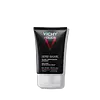What's inside
What's inside
 Key Ingredients
Key Ingredients

 Benefits
Benefits

 Concerns
Concerns

 Ingredients Side-by-side
Ingredients Side-by-side

Water
Skin ConditioningGlycerin
HumectantAlcohol Denat.
AntimicrobialPropanediol
SolventDimethicone
EmollientPhenyl Trimethicone
Skin ConditioningPropylene Glycol
HumectantC13-14 Isoparaffin
EmollientCI 15985
Cosmetic ColorantCI 77491
Cosmetic ColorantCI 77492
Cosmetic ColorantCI 77499
Cosmetic ColorantCI 77891
Cosmetic ColorantTriethanolamine
BufferingTriethyl Citrate
MaskingSilica
AbrasiveSodium Dextran Sulfate
Gel FormingEscin
TonicPhenoxyethanol
PreservativeMagnesium Sulfate
Magnesium Ascorbyl Phosphate
AntioxidantBoron Nitride
AbsorbentAscorbyl Glucoside
AntioxidantCaprylyl Glycol
EmollientLaureth-7
EmulsifyingAcrylates/C10-30 Alkyl Acrylate Crosspolymer
Emulsion StabilisingPolyacrylamide
Acrylates/Ammonium Methacrylate Copolymer
Parfum
MaskingWater, Glycerin, Alcohol Denat., Propanediol, Dimethicone, Phenyl Trimethicone, Propylene Glycol, C13-14 Isoparaffin, CI 15985, CI 77491, CI 77492, CI 77499, CI 77891, Triethanolamine, Triethyl Citrate, Silica, Sodium Dextran Sulfate, Escin, Phenoxyethanol, Magnesium Sulfate, Magnesium Ascorbyl Phosphate, Boron Nitride, Ascorbyl Glucoside, Caprylyl Glycol, Laureth-7, Acrylates/C10-30 Alkyl Acrylate Crosspolymer, Polyacrylamide, Acrylates/Ammonium Methacrylate Copolymer, Parfum
Water
Skin ConditioningDimethicone
EmollientGlycerin
HumectantZea Mays Starch
AbsorbentIsohexadecane
EmollientSorbitan Stearate
EmulsifyingC13-14 Isoparaffin
Emollient2,6-Dimethyl-7-Octen-2-Ol
MaskingStearyl Alcohol
EmollientAmmonium Polyacryloyldimethyl Taurate
Emulsion StabilisingPoloxamer 338
EmulsifyingDisodium EDTA
Sucrose Cocoate
EmulsifyingCaprylyl Glycol
EmollientHydroxyapatite
AbrasiveLaureth-7
EmulsifyingEperua Falcata Bark Extract
Skin ProtectingDextrin
AbsorbentLactic Acid
BufferingPolyacrylamide
Water, Dimethicone, Glycerin, Zea Mays Starch, Isohexadecane, Sorbitan Stearate, C13-14 Isoparaffin, 2,6-Dimethyl-7-Octen-2-Ol, Stearyl Alcohol, Ammonium Polyacryloyldimethyl Taurate, Poloxamer 338, Disodium EDTA, Sucrose Cocoate, Caprylyl Glycol, Hydroxyapatite, Laureth-7, Eperua Falcata Bark Extract, Dextrin, Lactic Acid, Polyacrylamide
Alternatives
Ingredients Explained
These ingredients are found in both products.
Ingredients higher up in an ingredient list are typically present in a larger amount.
This ingredient is also known as "C13-14 Isoalkane".
C13-14 Isoparaffin is created from petroleum-based mineral oils. It is an emollient and helps thicken a product.
As an emollient, it helps keep the skin soft and smooth by creating a barrier on top. This barrier traps moisture in, keeping the skin hydrated.
C13-14 Isoparaffin may not be fungal-acne safe.
Learn more about C13-14 IsoparaffinCaprylyl Glycol is a humectant and emollient, meaning it attracts and preserves moisture.
It is a common ingredient in many products, especially those designed to hydrate skin. The primary benefits are retaining moisture, skin softening, and promoting a healthy skin barrier.
Though Caprylyl Glycol is an alcohol derived from fatty acids, it is not the kind that can dry out skin.
This ingredient is also used as a preservative to extend the life of products. It has slight antimicrobial properties.
Learn more about Caprylyl GlycolDimethicone is a type of synthetic silicone created from natural materials such as quartz.
What it does:
Dimethicone comes in different viscosities:
Depending on the viscosity, dimethicone has different properties.
Ingredients lists don't always show which type is used, so we recommend reaching out to the brand if you have questions about the viscosity.
This ingredient is unlikely to cause irritation because it does not get absorbed into skin. However, people with silicone allergies should be careful about using this ingredient.
Note: Dimethicone may contribute to pilling. This is because it is not oil or water soluble, so pilling may occur when layered with products. When mixed with heavy oils in a formula, the outcome is also quite greasy.
Learn more about DimethiconeGlycerin is already naturally found in your skin. It helps moisturize and protect your skin.
A study from 2016 found glycerin to be more effective as a humectant than AHAs and hyaluronic acid.
As a humectant, it helps the skin stay hydrated by pulling moisture to your skin. The low molecular weight of glycerin allows it to pull moisture into the deeper layers of your skin.
Hydrated skin improves your skin barrier; Your skin barrier helps protect against irritants and bacteria.
Glycerin has also been found to have antimicrobial and antiviral properties. Due to these properties, glycerin is often used in wound and burn treatments.
In cosmetics, glycerin is usually derived from plants such as soybean or palm. However, it can also be sourced from animals, such as tallow or animal fat.
This ingredient is organic, colorless, odorless, and non-toxic.
Glycerin is the name for this ingredient in American English. British English uses Glycerol/Glycerine.
Learn more about GlycerinLaureth-7 is created by the ethoxylation of lauryl alcohol using ethylene oxide. Lauryl alcohol is a fatty alcohol with hydrating properties.
This ingredient is an emulsifier and cleansing ingredient. As an emulsifier, it is used to prevent ingredients from separating. It also helps cleanse the skin by gathering dirt, oil, and pollutants to be rinsed away.
Polyacrylamide is a synthetic polymer. It is used to stabilize products and bind ingredients. When hydrated, Polyacrylamide forms a soft gel.
Polyacrylamide is low-toxicity. If source properly, it is deemed safe to use in cosmetics.
It should be noted the precursor to Polyacrylamide is acrylamide. Acrylamide is a carcinogen. Most reputable sources of Polyacrylamide will screen for residual acrylamide to make sure the count is in a safe range. Acrylamide is not able to be absorbed through the skin.
We recommend speaking with a professional if you have concerns.
Learn more about PolyacrylamideWater. It's the most common cosmetic ingredient of all. You'll usually see it at the top of ingredient lists, meaning that it makes up the largest part of the product.
So why is it so popular? Water most often acts as a solvent - this means that it helps dissolve other ingredients into the formulation.
You'll also recognize water as that liquid we all need to stay alive. If you see this, drink a glass of water. Stay hydrated!
Learn more about Water